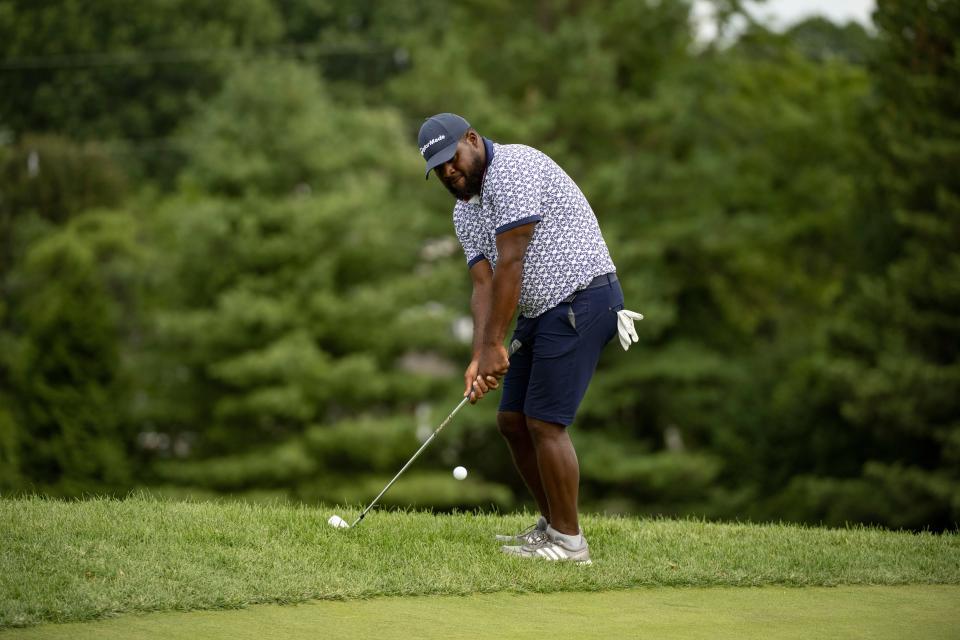'Tiger Effect' didn't produce a wave of Black pro golfers, so APGA Tour tries to do it
ATLANTA — At the end of every FedExCup, with its $18 million top prize on the line, the PGA Tour celebrates holding its championship event at East Lake, an exclusive golf club in the middle of a racially diverse, mixed income Atlanta neighborhood that has been revitalized through public planning, corporate investment and tens of millions in philanthropy that the Tour and its sponsors have helped raise.
It is, of course, a worthy effort that has anchored one of professional golf’s signature events to a unique location, smack in the middle of a city that has more Black residents than white.
And yet more than 25 years after Tiger Woods won his first Masters, all of the sport’s grassroots investments have failed to result in more diversity at the highest level, with only a few people of color on the PGA Tour. Among the 30 players who made it to East Lake, the only golfers of color represented among American players are Polynesian (Tony Finau) and Asian-American (Collin Morikawa).
“I think we, as an industry, thought Tiger introduced the game to a lot of people so therefore the game is going to grow and we will have more Black and brown professionals,” said Kenyatta Ramsey, the Tour’s senior director of player development. “But there’s so many things that go into being a professional, and I think as an industry it probably took time to understand that we’ve got to go a little bit deeper.”
A significant part of that depth unfolded last week, about a 40-minute drive into the Atlanta suburbs at TPC Sugarloaf, a private club whose fairways are lined with multi-million dollar homes.
On Aug. 14 and 15, TPC Sugarloaf hosted the top event of the APGA Tour — the A standing for “Advocates” — where 55 players competed for the season’s biggest prize of $55,000 over 36 holes. With a few exceptions, the field was comprised of young, Black players — some still ascending, others barely hanging on to their dreams — who are at least a couple of steps away from the PGA Tour.
For any of them, the odds of making it are long. But with the support of the PGA Tour over the last few years, which includes everything from securing top-notch facilities for tournaments to connecting some of the top prospects with coaching, potential sponsors and other developmental resources, the APGA is hoping to become the kind of incubator for golfers of color that was maybe taken for granted in the years after Woods’ surge to the top of the sport.
“At this rate, there will be a handful of us out there for sure,” said Aaron Grimes, who has spent the last few seasons playing primarily on the APGA Tour. “As long as you don’t quit.”
Given the realities of life on golf’s various mini-tours, that’s not always easy.
'Guys quit because they run out of money'
Grimes started playing golf with his family at a par-3 course in Compton, California, and got good enough to play at a junior college and then ultimately Cal State-Northridge as a walk-on.
But even if you believe you’re good enough to make a living playing golf, how do you transition from there to a life on tour? Some players are so accomplished in juniors, their pathway is clear. Others find sponsors or have their family provide the seed money necessary to fund all the travel and coaching and equipment that the sport requires.

Ultimately, that’s the barrier a lot of people in general — but particularly in communities of color — simply can’t overcome when they try to work their way up. Grimes, who is 29, estimated that he was going to spend about $7,000 to play a stretch of four APGA events in late July and early August. He took home just shy of $4,000 in prize money.
“There are players that have all the talent, but having those endless funds is unheard of on this level, and a lot of guys quit because they run out of money,” Grimes said. “I don't come from money. My parents worked until they’re well into their 60s and I couldn't ask them. So I started caddying at a country club to support my competitive efforts. I always had to go back and caddy whenever I ran out of money.”
The financial realities illustrate why the APGA is supposed to be a pit stop for players, not a destination. Ken Bentley, a former executive at Nestle who founded the APGA in 2010, recalled a conversation he had earlier this season with Marcus Byrd, a 26-year-old from just outside Washington, D.C., who has been the tour's best player this year.
“I said, ‘I don’t want to see you back here next January,’ " said Bentley, who played college and professional tennis for a time. “The APGA is not a destination, it’s a pass-through. I want to see you out there.”
When Byrd left Middle Tennessee State in 2019, he was named Conference USA's golfer of the year and ranked among the top 100 amateurs in the world. But getting together the start-up funds was a challenge, and he too had to work as a caddy to defray expenses. The APGA, with its low entry fees, was a sensible place to start playing.
Now he is focusing on the PGA Tour’s Q-School, which costs thousands in entry fees at each of its four stages but offers the opportunity for players to earn membership either on the big tour or one step below on the Korn Ferry Tour.
“I think the reason you don’t see a lot more Black players out there is we haven’t had the same opportunity to perform and get the reps we need at the highest level like some of these guys have, all the way from junior golf to professional golf,” Byrd said. “I think that’s going to change over the next five to 10 years for sure.”
How Arthur Ashe's legacy inspired APGA
Though it’s hard to pinpoint exactly why the Tiger Effect didn’t result in a wave of Black players rising through the ranks organically, even the PGA Tour now acknowledges that it didn’t fully capitalize on the opportunity and build the necessary networks to promote diversity. Today, the most prominent Black player competes in LIV Golf (Harold Varner III), while Cameron Champ and Joseph Bramlett have had some success on the PGA Tour.
When Bentley thought about starting the APGA, he leaned on his background in tennis, where Arthur Ashe had come through a system in Richmond, Virginia, that had already been established for Black players by Dr. Robert Johnson. That infrastructure allowed Ashe to not only learn but compete regionally and nationally before landing at UCLA and becoming a huge star in 1968 when he won the U.S. Open.

“I wanted to just have some tournaments because I thought if you gave guys a chance to play, they would get better,” Bentley said. “But then I found out most of the guys had never been fitted for clubs. They were taking lessons from a local pro at the First Tee courses. So I quickly realized that wasn’t enough.”
For about a decade, Bentley tried to run the tour with a very small staff and almost no funding. A couple of years into it, one of his connections helped the APGA get on the PGA Tour’s radar, and they started sending him a $20,000 annual check. For several years, that was the extent of the Tour’s interest.
Then one day, Bentley got a call from Tour executive Allison Keller, asking him to come to the Tour’s headquarters and make a presentation that would either lead to a significant expansion of the relationship or an end to the $20,000 checks.
By the end of it, the PGA Tour had committed to a variety of helpful measures, including access to coaching at their TPC Sawgrass facilities and help with equipment fitting for some top players. The affiliation has also helped the APGA bring events to top-level courses like TPC Sugarloaf, which previously hosted a PGA Tour event and can approximate a true professional golf test.
“Ultimately, we want the tour to look more like America,” Ramsey said. "And in order to do that, we’ve got to invest in the development of that talent from those communities. There’s a lot of talent outside of the stereotypical golfer, and if you invest in that talent, they’ll go a lot farther than they would have before.”
As a result, the APGA looks quite a bit different than it did a few years ago.
APGA golfers must 'feel like they belong'
The tour now has 18 events totaling more than $800,000 in prize money, including one at Torrey Pines that is televised and played in tandem with the PGA Tour's Farmers Insurance Open. Connections with the PGA Tour have resulted in some APGA players getting sponsor's exemptions into a few tournaments. And for the top-five Black college golfers every year, the APGA offers tour membership and money to pay for their Q-School fees the following year.
The APGA also has expanded its corporate partnerships with companies like Cisco, which provides sponsorship money to a select group of players that helps make ends meet without having to work day jobs.
“There’s a lot of guys without the APGA Tour, and especially without the sponsorship, that simply wouldn’t be doing it,” said Andrew Walker, a former Michigan State golfer. “It’s an expensive game. I made a bit of money last year, and I spent a bit more.”
Even for those who don't make it to the top level of golf, Bentley also sees an opportunity for players to come through the APGA and work in various sectors of the industry, from teaching to course design to equipment, diversifying the game on the corporate side as well as competitively.
But ultimately, the APGA wants to see one of its alums become a big-time star.
To this point, the APGA's most renowned alumnus is Willie Mack III, a 35-year-old who spent years grinding on the mini-tours until he got his Korn Ferry card this year and has made eight cuts in 18 events. Tim O’Neal graduated from the APGA and is now making an impact on the PGA Tour Champions.
Sooner or later, though, someone is going to break through and make that journey from APGA to East Lake and perhaps open the floodgates the way Tiger was supposed to.
“Our guys rarely hear something as simple as, ‘You know, I believe in you,’ ” Bentley said. "A lot of times they don’t believe because they haven't had someone tell them they can. We need more situations where our guys can feel like they belong."
This article originally appeared on USA TODAY: Tiger Effect didn't bring wave of Black golfers; APGA Tour is trying
